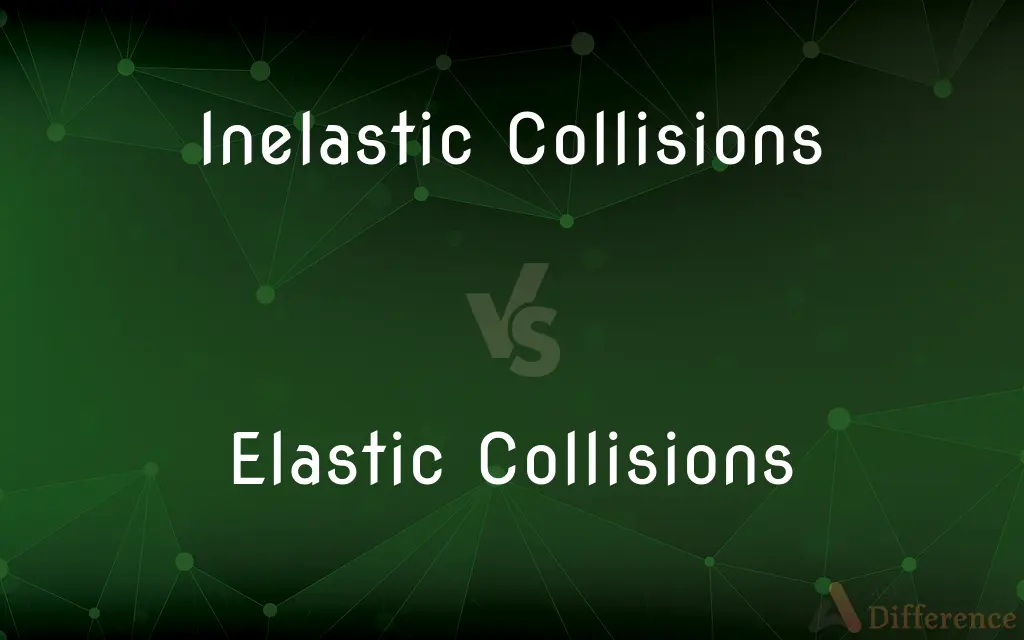Inelastic Collisions vs. Elastic Collisions — What's the Difference?
Edited by Tayyaba Rehman — By Fiza Rafique — Published on December 4, 2023
Inelastic Collisions involve objects sticking together or deforming, with kinetic energy not conserved. Elastic Collisions have objects bouncing off each other with kinetic energy conserved.

Difference Between Inelastic Collisions and Elastic Collisions
Table of Contents
ADVERTISEMENT
Key Differences
In Inelastic Collisions, two objects collide and do not retain their initial kinetic energy. In Elastic Collisions, the kinetic energy before and after the collision remains the same.
In Inelastic Collisions, the objects might stick together after the impact or change shape. Elastic Collisions, on the other hand, ensure that the objects rebound off each other, maintaining their original shapes.
In Inelastic Collisions, the primary focus is on the conservation of momentum, not kinetic energy. However, in Elastic Collisions, both momentum and kinetic energy are conserved.
In terms of practical applications, Inelastic Collisions are often seen in accidents where vehicles get dented or objects deform. Elastic Collisions are typically observed in games like pool or when particles collide in ideal conditions.
While both Inelastic Collisions and Elastic Collisions follow the law of conservation of momentum, the key difference lies in the conservation of kinetic energy, which is present only in Elastic Collisions.
ADVERTISEMENT
Comparison Chart
Kinetic Energy Conservation
Not conserved
Conserved
Object Behavior
May stick together or deform
Always rebound without deforming
Momentum Conservation
Conserved
Conserved
Real-life Examples
Car accidents, dough bouncing
Pool balls colliding, ideal gas molecules
Application Focus
Conservation of momentum
Conservation of both momentum and kinetic energy
Compare with Definitions
Inelastic Collisions
Collisions where objects may stick or deform post-collision.
Two cars crashing and getting stuck together is an example of Inelastic Collisions.
Elastic Collisions
Collisions where the sum of the velocities remains unchanged before and after the collision.
Elastic Collisions ensure that the momentum and kinetic energy remain consistent pre and post-collision.
Inelastic Collisions
Collisions resulting in energy being transformed into other forms.
During Inelastic Collisions, the kinetic energy might transform into sound, heat, or deformation energy.
Elastic Collisions
Collisions where objects rebound without any deformation.
Billiard balls colliding and bouncing off each other showcase Elastic Collisions.
Inelastic Collisions
Collisions that don't conserve total kinetic energy.
When a clay ball hits a wall and stays deformed, it exemplifies Inelastic Collisions.
Elastic Collisions
Collisions conserving total kinetic energy.
When two steel balls collide and bounce back without losing speed, they're undergoing Elastic Collisions.
Inelastic Collisions
Collisions where the final combined velocity differs from the initial separate velocities.
In Inelastic Collisions, two slow-moving objects might stick together and move faster post-collision.
Elastic Collisions
Perfect collisions where energy loss is minimal or nonexistent.
Gas molecules undergoing Elastic Collisions bounce back without energy loss.
Inelastic Collisions
Collisions involving momentum conservation but not necessarily kinetic energy conservation.
Two dough balls sticking together after collision follow the rules of Inelastic Collisions.
Elastic Collisions
Collisions that don't transform kinetic energy into other forms.
In Elastic Collisions, no kinetic energy is transformed into heat or sound.
Common Curiosities
What's the primary difference between Inelastic Collisions and Elastic Collisions?
Inelastic Collisions don't conserve kinetic energy, while Elastic Collisions do.
Are Inelastic Collisions always about objects sticking together?
Not always; in Inelastic Collisions, objects might stick or simply deform.
Do Inelastic Collisions result in energy loss?
Yes, in Inelastic Collisions, kinetic energy is transformed into other forms, leading to a perceived loss.
Can Elastic Collisions occur in real-life scenarios?
While ideal Elastic Collisions are rare in everyday life, close approximations, like billiard ball collisions, do occur.
Is momentum conserved in both types of collisions?
Yes, momentum is conserved in both Inelastic Collisions and Elastic Collisions.
Do Elastic Collisions only pertain to solid objects?
No, Elastic Collisions can also refer to particles, atoms, or molecules, especially in theoretical or controlled environments.
Can two objects move faster together after Inelastic Collisions?
Yes, if two objects stick together after an Inelastic Collision, their combined velocity might be different from their initial separate velocities.
Can objects deform in Elastic Collisions?
No, in Elastic Collisions, objects rebound without deformation.
Does temperature affect Elastic Collisions?
In cases like gas particle collisions, increasing temperature can increase the frequency and energy of Elastic Collisions.
Why don't we see perfect Elastic Collisions often in real life?
Perfect Elastic Collisions are rare because some energy is usually transformed into heat, sound, or other forms during most collisions.
In which collision type is kinetic energy always conserved?
Kinetic energy is always conserved in Elastic Collisions.
Are all car accidents examples of Inelastic Collisions?
Most car accidents are Inelastic Collisions as cars deform or crumple upon impact.
Are there practical applications where Elastic Collisions are crucial?
Yes, Elastic Collisions principles are fundamental in games like pool and in some physics experiments.
Can sound be produced in both types of collisions?
Yes, but it's more common in Inelastic Collisions where energy is often transformed into sound.
Can the shape of an object change permanently in Elastic Collisions?
No, objects involved in Elastic Collisions rebound without permanent deformation.
Share Your Discovery

Previous Comparison
Research Proposal vs. Research Report
Next Comparison
Valence Bond Theory vs. Molecular Orbital TheoryAuthor Spotlight
Written by
Fiza RafiqueFiza Rafique is a skilled content writer at AskDifference.com, where she meticulously refines and enhances written pieces. Drawing from her vast editorial expertise, Fiza ensures clarity, accuracy, and precision in every article. Passionate about language, she continually seeks to elevate the quality of content for readers worldwide.
Edited by
Tayyaba RehmanTayyaba Rehman is a distinguished writer, currently serving as a primary contributor to askdifference.com. As a researcher in semantics and etymology, Tayyaba's passion for the complexity of languages and their distinctions has found a perfect home on the platform. Tayyaba delves into the intricacies of language, distinguishing between commonly confused words and phrases, thereby providing clarity for readers worldwide.
















































